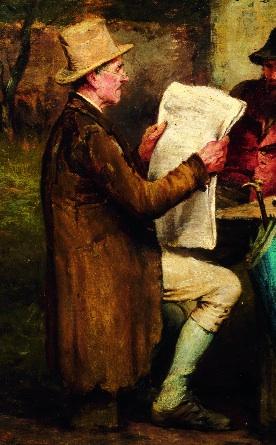Poring over the entrails: History Ireland readers’ survey
Published in 20th-century / Contemporary History, Issue 5 (Sep/Oct 2006), News, Volume 14
For our regular readers, the hard copy is the real thing. (National Gallery of Ireland)
It’s stating the obvious, but no less true for that, to say that History Ireland wouldn’t exist without its readers. Over the years, many of you have taken the time to let me know what you think of the magazine. Our reader survey, conducted towards the end of 2005, sought to find out in more detail what you think of us. Nearly 300 of you took the trouble to reply, and we thought you would be interested in the results.
Satisfaction with the content is very high. For the coverage of particular periods and themes, you were asked to say whether you would like to see ‘more’ or ‘less’ of that topic, or whether it’s ‘about right’. In nearly every case a majority thought that it was ‘about right’. Each period had its fans, however—about 30 per cent would like to see more of each. A few themes stood out as needing even more coverage—46 per cent want more social and cultural history, and 51 per cent would like to see more local history (although it was not clear whether this reflected a desire for more of the history of the respondents’ own localities.) In only a few cases did a significant percentage think that too much attention was paid to certain topics: non-Irish history, a recent innovation, did not find favour with 43 per cent of respondents, and some people expressed themselves forcefully on this point. On the other hand, the international perspective was apparent in many suggestions for content dealing with Ireland’s influences on and links with other countries and the impact of the Irish diaspora.
Many of you offered suggestions for specific topics to be covered, especially local, regional (e.g. Ulster), social, cultural and religious issues. The critical early twentieth-century events are fascinating for many, and the recent contribution of Peter Hart and the ensuing debate generated numerous comments, both for and against.
Satisfaction with the format and sections of the magazine (e.g. features, news and shorts, reviews, etc.) was also very high. In every case a majority thought that it was about right, with a significant minority wanting to see even more of most sections. Only in relation to the curriculum section and interviews did a significant number (24 per cent and 23 per cent respectively) want to see less. A wide range of helpful ideas was suggested, especially with regard to making History Ireland a more useful source of information about history-related events and activities.
Many of you commented favourably on the ‘look and feel’ of the magazine. The illustrations, layout and production quality all drew positive remarks. Perhaps it is their appreciation of the physical appearance of the magazine that makes people less attracted to an on-line version, in which only about one in six expressed an interest. On-line publication has an appeal for certain markets, for example institutions and researchers, but for our regular readers the hard copy is the real thing.
Your passion for history is not limited to buying the magazine. Over a third of respondents are members of local history societies. About half of you expressed an interest in additional services and activities associated with History Ireland, such as conferences, talks and book clubs, and one in three would like to take part in outings or events. Surprisingly, advertising is seen as an integral and useful feature of the magazine. Nearly all respondents read the advertisements, and two-thirds say that they have made purchases as a result.
The most frequent cause for complaint relates to availability and distribution. For 38 per cent of those who don’t have a subscription getting a copy is often a problem, especially outside the major urban centres. This is something outside our immediate control. The solution? Subscribe! Many readers made useful suggestions for ways to encourage readers to become regular subscribers, a critical factor in the success of specialist publications such as History Ireland.
Though only a small percentage of the total readership replied to the survey, a response from nearly 300 readers is good for surveys of this type. As one would expect, those who replied are more typical of the loyal, long-term reader than the casual buyer. Rather more surprising was the distinctive demographic profile of respondents—male (79 per cent), middle-aged (67 per cent are aged 50+), and in an occupation requiring a medium to high level of professional or academic training. Clearly there is a challenge here for us to broaden our appeal. Is it true that history is less appealing to women, or is it just that men are more likely to answer surveys?
















